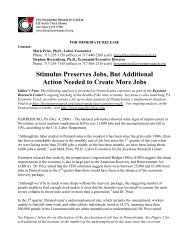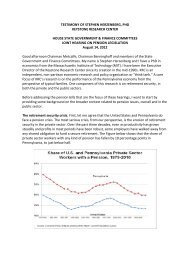The State of Working Pennsylvania 2004 - The Keystone Research ...
The State of Working Pennsylvania 2004 - The Keystone Research ...
The State of Working Pennsylvania 2004 - The Keystone Research ...
Create successful ePaper yourself
Turn your PDF publications into a flip-book with our unique Google optimized e-Paper software.
<strong>The</strong> <strong>State</strong> <strong>of</strong> <strong>Working</strong> <strong>Pennsylvania</strong> <strong>2004</strong> 18<br />
JOB QUALITY, 1979-2003<br />
Wages and salaries account for about three-quarters <strong>of</strong> family income on average. <strong>The</strong>y account<br />
for an even larger share <strong>of</strong> the incomes <strong>of</strong> middle- and low-income families. Wages are, therefore, a<br />
major determinant <strong>of</strong> living standards for most families and a key influence on income inequality.<br />
This section examines trends in wage levels and wage inequality from 1979 through 2003.<br />
As in previous editions <strong>of</strong> <strong>The</strong> <strong>State</strong> <strong>of</strong> <strong>Working</strong> <strong>Pennsylvania</strong> this edition focuses much <strong>of</strong> its analysis<br />
on the median wage. <strong>The</strong> median is the wage earned by the person whose wage falls exactly in the<br />
middle <strong>of</strong> the wages <strong>of</strong> all workers. Median wage earners earn more than half <strong>of</strong> all workers and less<br />
than the other half. <strong>The</strong> median wage is the best measure <strong>of</strong> a typical worker’s wage.<br />
<strong>Pennsylvania</strong> Wages Down Since 2002<br />
After falling from 1979-1989, stagnating from 1989-1995, and rising substantially from 1995-<br />
2000 and 2000-2002, <strong>Pennsylvania</strong>’s inflation-adjusted median hourly wage fell by four cents per<br />
hour from 2002-2003 (Table 3 and Figure 11). Although the state’s median wage continued to rise<br />
during and shortly after the 2001 recession and remains higher than it was in 2000 (the year before<br />
the recession began), last year’s wage decline could be a result <strong>of</strong> the long period <strong>of</strong> job market slack<br />
that began during the recession and continued until earlier this year.<br />
Table 3. Median Hourly Wages in <strong>Pennsylvania</strong> and the United <strong>State</strong>s, 1979-2003 (2003<br />
dollars)<br />
All Workers Men Women<br />
PA U.S. PA U.S. PA U.S.<br />
1979 $12.84 $12.36 $15.97 $15.55 $9.75 $9.74<br />
1989 12.35 12.36 14.44 14.46 10.20 10.57<br />
1995 12.35 12.14 14.40 13.94 10.64 10.69<br />
2000 13.15 13.07 15.50 14.89 11.26 11.61<br />
2002 13.63 13.47 15.34 15.17 12.10 12.16<br />
2003 13.59 13.62 15.21 15.04 12.16 12.18<br />
Percent Change<br />
1979-2003 5.8% 10.2% -4.8% -3.3% 24.7% 25.1%<br />
1989-2003 10.0 10.2 5.3 4.0 19.2 15.2<br />
1995-2003 10.0 12.2 5.6 7.9 14.3 13.9<br />
2000-2003 3.3 4.2 -1.9 1.0 8.0 4.9<br />
2002-2003 -0.3 1.1 -0.8 -0.9 0.5 0.2<br />
Source: Economic Policy Institute (EPI) analysis <strong>of</strong> Current Population Survey (CPS) data.<br />
<strong>Pennsylvania</strong>’s wage performance in the last year lagged behind that <strong>of</strong> the nation as a whole in both<br />
wage levels and wage growth. During most <strong>of</strong> the period since 1979 <strong>Pennsylvania</strong>’s median wage was<br />
higher than that <strong>of</strong> the nation as a whole but in 2003 it was three cents per hour below the national<br />
median. And while <strong>Pennsylvania</strong>’s median wage fell from 2002-2003 the national median wage rose<br />
by 15 cents per hour.







